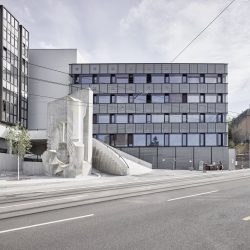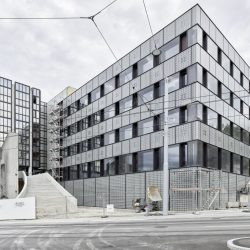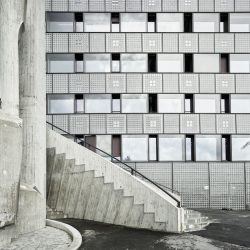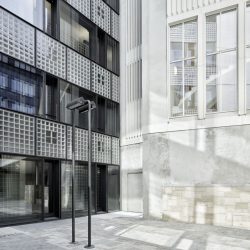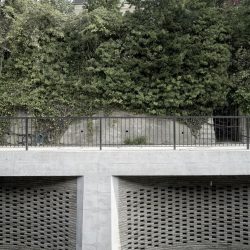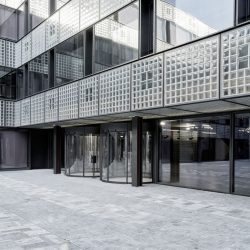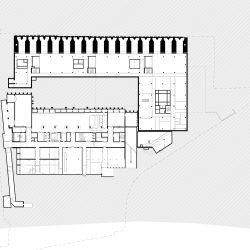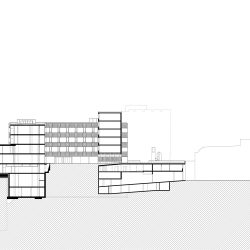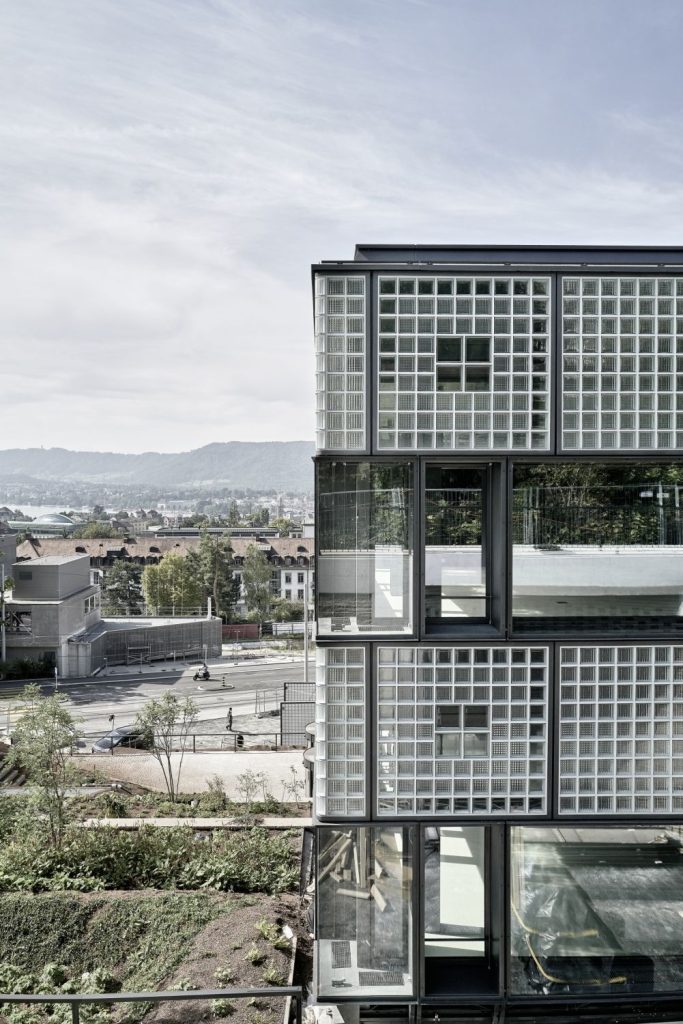
Boltshauser Architekten . photos: © Kuster Frey
The GLC building of ETH Zurich serves teaching and research at the interface between health sciences and technology. It is part of the dense conglomeration of buildings that make up Zurich’s university quarter and fits into an ensemble originating in the Semper Polytechnic and university building from the middle of the 19th century and which has evolved continuously to this day. As part of the 2012/2020 Real Property Strategy, the ETH decided to build a new center for the departments of health sciences and technology, information technology, and electrical engineering at the site of the hydraulic engineering, hydrology and glaciology research institute (VAW), holding a competition in 2010/2011 for this building which is now referred to by the abbreviation GLC.
The new building complex is one of the first components of the 2014 master plan for Zurich’s university quarter, which was finalized in the course of planning and construction. Together with the existing ETZ building, the roughly 110-meter-long new-build forms a courtyard and thus fits in with the existing typology of the university quarter. The listed Paul Scherrer lecture hall in the middle became the centerpiece of the whole new complex. The unification of the new and existing buildings led to a clarification of the urban planning situation and enabled operational synergies. Due to the hillside location, the development of the cross-section was particularly demanding. With the condition of not detracting from the view of the lake from the villa quarter, only five stories were possible on the street side. On the slope side, only two floors are visible, which meant that the seven-story building had to be secured on the extensive slope in a sophisticated way that could be exploited for both architectural and technical purposes.
A new curved external staircase along the arc of Gloriastrasse forms a distinctive point of entry. The form, developed on the basis of mathematical principles, was designed in collaboration with the artist Urs Beat Roth as an Art and Architecture project and integrates an existing concrete sculpture by the sculptor Fredi Thalmann. On the upper level, users reach the courtyard via the existing passageway, that forms the new address of the complex. Located here are the main entrance to the new-build and the entrances to the Paul Scherrer lecture hall and the ETZ electrical engineering building.
The entrance floor contains public facilities including the foyer, restaurant, seminar, and group rooms, and workplaces for students. Three upper floors house laboratories and offices, with three basement floors accommodating special laboratories, equipment, and service rooms. An atrium with zenithal lighting welcomes students and scientists, and a virtuoso double main staircase connects the entrance hall with the upper floors. Niche-like lounge areas add rhythm to the annular circulation zones and provide a direct connection to the existing building adjacent. Professorial offices are located in the front building on Gloriastrasse, with the spacious laboratory areas situated on the side of the slope allowing flexible division. The laboratories on the basement floors are protected by the retaining wall detached from the building.
The glass and stone facades of the new-build follow the long tradition of glass block facades in modernist industrial and university buildings. In particular, the nearby distant heating power plant and machine laboratory of the ETH by Otto Rudolf Salvisberg (1930 –1935) was the motivation to rethink this building material in terms of design, technique, and energy. As a double-skin construction with glass block elements joined in the manner of coffers, the new facade achieves a dignified gravity as well as a three-dimensionality, which the neighboring facade lacks. Glass block parapets and strip windows create a horizontal structure that is superimposed by the vertical order of the recessed casements. Fine steel frames divide the strips into square and rectangular formats. The square elements have brooch-like glass block infills with different formats and structures. The larger blocks in the middle establish a link with the casements, thus strengthening the verticality within the horizontal strip.
On the slope side, the glass facade stands opposite the solid load-bearing slope stabilization structure, making for an effective contrast. The impressive structure is conceived as an arc-segment-shaped retaining wall that transitions into diaphragm wall slabs anchored in the bedrock. The escarped curved wall is more than 110 meters in length and around eighteen meters high and transfers the forces in a clear and expressive manner.
If one were to include the underground section, the retaining structure which transfers forces directly into the ground, is approximately forty-four meters high. Thanks to this, the new build remains flexible in its load-bearing structure and the existing buildings are spared additional shear forces. The cavities in the barrel-shaped wall serve as an in-wall cooling system: fresh air is taken in and fed into the ventilation systems, and the vast mass of the soil is activated to cool the laboratories, thus saving considerable amounts of energy.
In the various views, the coffer-like composition of the glass facades creates the impression of relief. Inside, it acts as a brise-soleil, creating different levels of transparency and lighting ambiance. The interspace of the double skin is climate-controlled, with air flowing through in the summer and buffered in the winter. As a result, the double-skin facade not only helps make good use of daylight but also plays a role in regulating the indoor climate.
A hierarchically graduated visibility of conduits and building service elements defines the character of the spaces. While no conduits are visible in the entrance hall and corridors, they are increasingly present in the lounge and work areas, becoming a defining element, graduated from the circulation spaces and the semi-public areas of the seminar rooms, restaurants, student workplaces, and office rooms to the laboratories. In terms of the separation of systems, the arrangement of conduits is an integral part of the architectural design, visualizing the number of technical installations in the various rooms.
Acoustic elements and light fixtures are integrated with the cooling panels. A specially developed additive LED lamp system can hold additional technical elements such as fire alarms and motion detectors as needed. The building is connected to the ETH Zentrum district heating and district cooling grid. It meets the standards of ETH Zürich and was realized in compliance with and in implementation of the building standards DGNB / SGNI Gold, Minergie-ECO, and GI Gutes Innenraumklima (good indoor climate construction standards).
_
Architects
Boltshauser Architekten AG
Address
ETH Zürich, Gloriastrasse 35, 8093 Zurich
Year
2021
Client
ETH Immobilien Zürich
Team
Armin Baumann, Fabio Tammaro, Angela Tsang, Stephan Schülecke, Giuseppe Pascoli, Marco Zingg, Daniel Christen, Mike Azzaoui, Elias Binggeli, Jan-Miro Joest, Christof Giger, Nicola Nett, Sascha Laue, Erica Pasetti, Urs Ringli, Simon Spring, Emanuel Stieger, Alexander Wright, Adrian Zimmermann, Luise Banz, Lorain Bernasconi, Manuel Fernandez, Janina Flückiger, Marle Freitag, Nadia Gloor, Sina Hettler, Linus Huber, Katarzyna Pankowska, Matthias Petersheim, Maximilian Prücklmeier, Bianca Schifani, Lenz Schnell, Silvia Stefanova, Sandro Straube, Jonas Sundberg, Yasemin Özdemir, Remo Fässler
Landscape architecture
Mettler Landschaftsarchitektur, Berlin
Structural engineer, building physics, energy consultant
Basler & Hofmann AG, Zurich
HVAC engineering, coordination services
Waldhauser & Hermann, Münchenstein
Services engineer
Balzer Ingenieure AG, Winterthur
Electrical engineer
IBG B. Graf AG Engineering, Winterthur
Facade consultant
Feroplan Engineering AG, Zurich
Sustainability consultant
Durable GmbH, Zurich
Lighting consultant
Reflexion AG, Zurich
Acoustics consultant
Mühlebach Partner AG, Winterthur
Building automation consultant
SSE Engineering AG, Gümligen
Laboratory planner
Laborplaner Tonelli AG, Gelterkinden
Gastronomy consultant
Promafox AG, Bad Zurzach
Fire protection consultant
Gruner AG, Zurich
Smoke pressure systems
Gruner-Roschi AG, Köniz
Door engineering consultant
Brütsch Elektronik AG, Uhwiesen
Door engineering consultant
OSC GmbH, Brüttisellen
Drainage consultant, exterior facilities
Hydraulik AG, Zurich
Traffic consultant
Enz und Partner AG, Zurich
General contractor
Steiner AG, Zurich
Facade
Aepli Metallbau AG, Gossau
Facade
Ruch Metallbau AG, Altdorf
Glass blocks
Semadeni Glasbetonbau AG, Horgen
Metalwork
Klausner Wetter Metallbau AG, Auw

